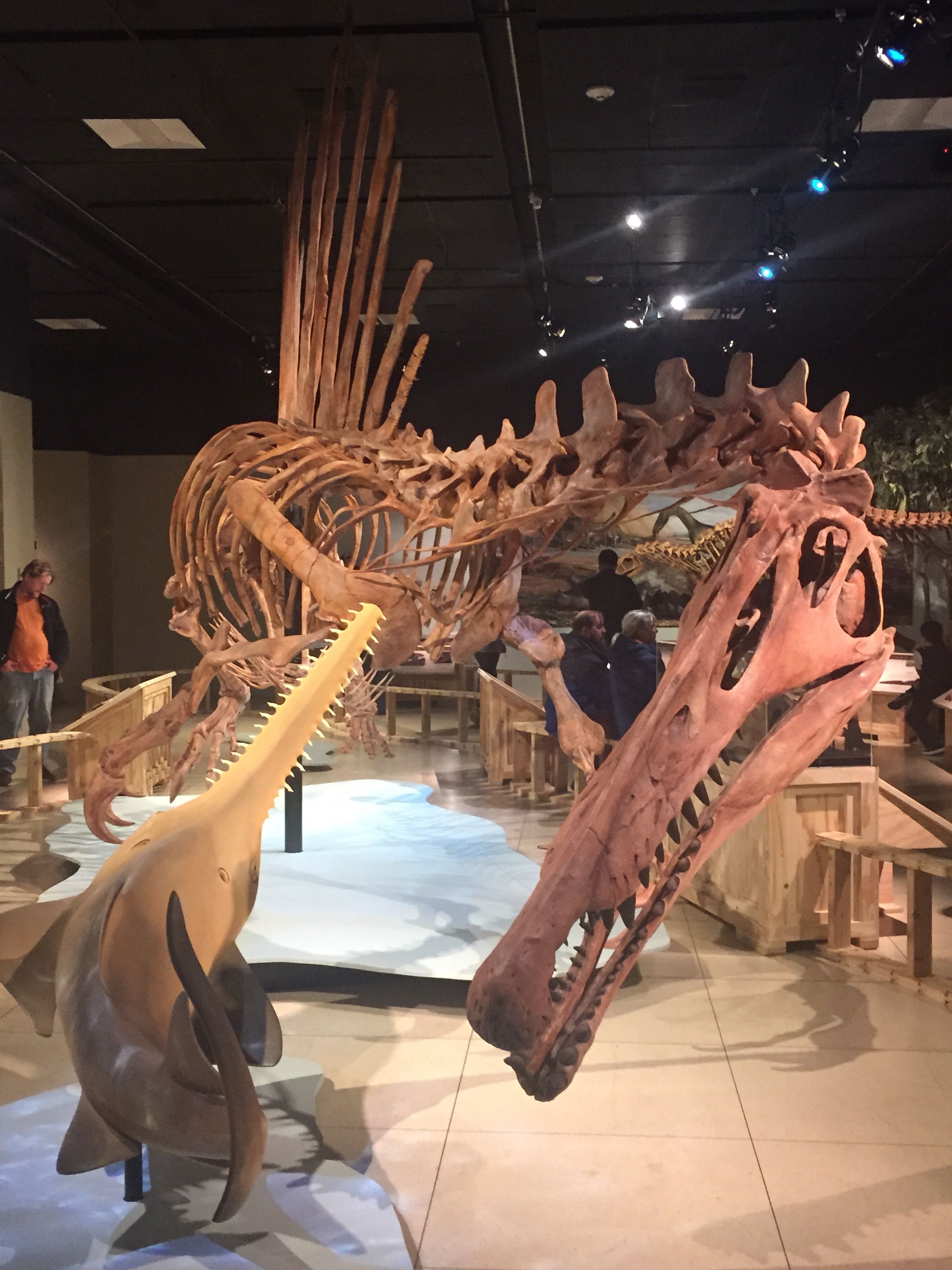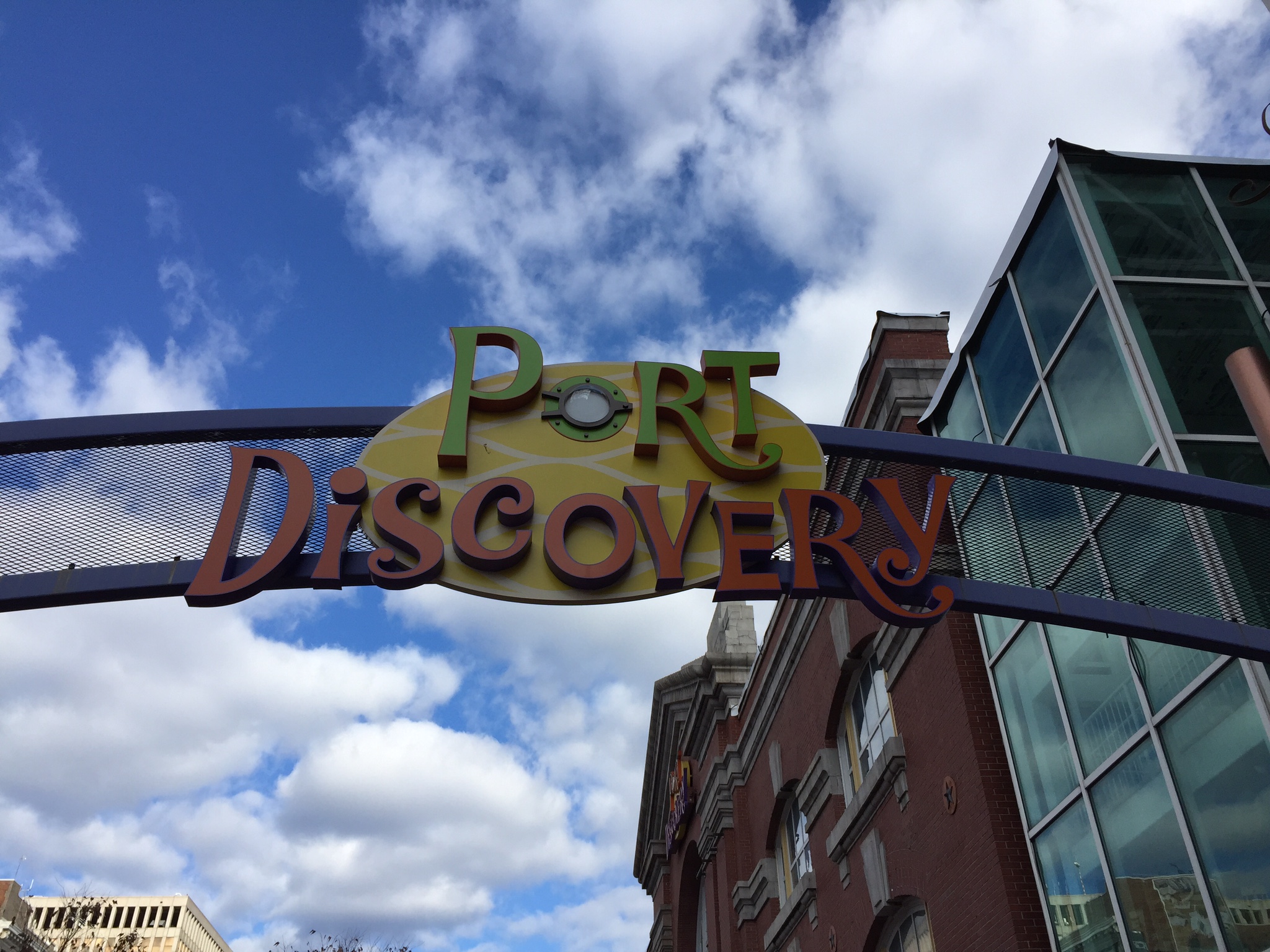Looking at my kid’s room, you might get the impression that he loves dinosaurs. Dinosaur blanket, dinosaur decals on the walls, dinosaur pajamas, a now-deconstructed dinosaur mobile. But of course, any decor intended for an infant reflects the parent’s interests, not the child’s.
The truth is, I love dinosaurs. I’ve been fascinated by them since I was little going from my initial childhood interest to an adolescent Jurassic Park obsession and into adulthood. So when I heard the National Geographic Museum was doing an exhibit on Spinosaurus, the largest predatory dinosaur ever found, I was really excited. After our bonkers December, we were finally able to visit it this past weekend. As a result of my overly-high expectations, I was a little disappointed. Nonetheless, it was a fascinating look at one of the biggest discoveries in paleontology in quite a while.
Beyond the creature’s sheer size, the skeleton has a unique history. Before WII, a German scientist discovered a somewhat complete fossil skeleton. Against his wishes, the Nazis refused to move it from a museum in Munich and it was destroyed when the Allies bombed the city. It remained a mystery for decades until it re-emerged in a Moroccan marketplace. An enterprising paleontologist spotted it briefly and didn’t quite know what it was until a colleague of his showed up with a partial skeleton. Through a combination of luck and persistence, the paleontologist tracked down the original seller and found out the location of the dig. It wasn’t until 2014 that they were actually able to escavate the site and publish their findings.
The first part of the exhibit told this story, through a series of videos, panels and dioramas. Unfortunately, Sprout does not yet have a strong (or any) interest in history. While I couldn’t get him to watch the movies, I did appreciate that they included a few “touchy-feely” elements, including a fossil cast and items similar to those sold in the Moroccan market like fossils and minerals. I knew the term “trilobite” was way too advanced for him, but I enjoyed mentioning it anyway.

The second half of the exhibit was all about the Spinosaurus itself, with the centerpiece being a huge reconstruction of the 50 ft beast. The display of the skeleton was quite good – it was in a dynamic position, ready to swallow a large saw-toothed fish. Around the room, there were plaques explaining the unique aspects of the Spinosaurus’ biology, from the sail on its back to its jaw full of sharp teeth perfect for eating fish. There were also a few other exhibits showing skeletons and models of dinosaur species that lived in the same region around the same time. I especially enjoyed a pterosaur overhead, looking like it would dive down any moment.
There were also some neat things about the set-up of the exhibit. The skeleton itself wasn’t the actual fossil – it was a 3D-printed model, made out of plastic. Also, a small comment at the end of the exhibit noted that when it finished, all of the fossils would be returned to Morocco. As the British Museum still has a patronizing message posted about how they can’t trust Greece enough to return parts of the Parthenon to them, I appreciated that consideration.
Nonetheless, there were some aspects that didn’t quite fulfill my high expectations. The exhibit was rather small, limited by both the lack of space and the fact it mainly focused on one species. It wasn’t very interactive, with only the aforementioned small “touchy-feely” aspects and a couple of iPads that repeated the same information on the panels. While I went to the exhibit because I was personally interested, I could see the fact that it wasn’t designed for small children could be frustrating for some parents. The history part would probably be dry to anyone under 10 and the discovery is so new that there’s simply not that much we know. Unlike the Smithsonians, the National Geographic Museum has an entry fee, so it seems especially important for its exhibits to prove their worth.
My frustration was undoubtably compounded by the fact that I had to cater to the whims of a sleep-deprived toddler. As Sprout refused to nap earlier in the day and we were in a museum, I was a little nervous about setting off the Whines. So I tried to read as much as I could while also following his lead. Unfortunately, he wasn’t interested in anything for more than 30 seconds, so I could only read dribs and drabs of text before being dragged away by an insistent little person. The panels weren’t very long at all, but some of them required me making two, three or even four passes to read. I came away with the impression of having read a series of tweets instead of a cohesive story. While I could have passed him off to Chris, I entertained hopes of a mommy-son museum bonding experience over dinosaurs. By the time I realized those hopes were misplaced, Chris was so far behind in his leisurely perusal that I couldn’t find him. Plus, as he’s Sprout’s primary caretaker, I like giving him a break on weekends and spending that one-on-one time with my son.
When Chris finally caught up – as I tried to manage the tiny bull in the gift shop – we went over to the museum’s other exhibit, Food: Our Global Kitchen. Needless to say, this was an extraordinarily broad topic. While I skimmed most of it, there were a couple of notable attractions. They had a series of kiosks where you could push a button and smell a food, including garlic, fennel and cinnamon. Sprout very much liked both smashing the buttons and sniffing the air. There was also a “test kitchen” that offered different samples each day. Much to my surprise, Sprout loved their green smoothies, to the point where he tried to lick the empty cup and fussed when I threw it away.
I do wish that we could have come when Sprout was a bit older and could appreciate it more, but the exhibit closes this spring. But considering the National Museum of Natural History’s Fossil Hall is closed for major renovations until Sprout is 6 (although some skeletons have been relocated), the Spinosaurus exhibit was a good hold-over.



